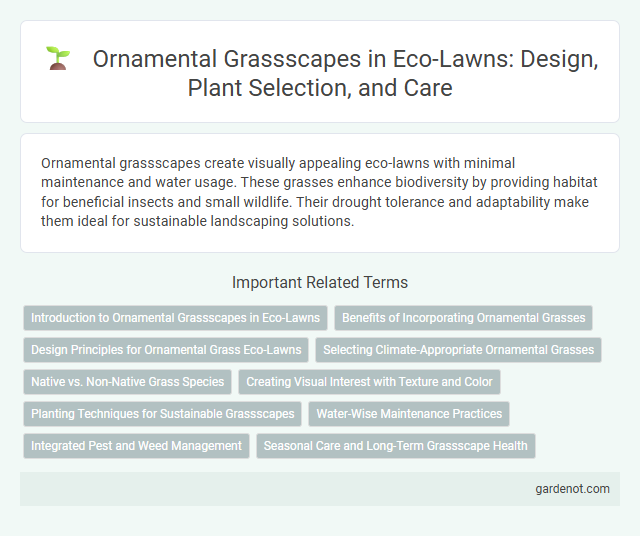Ornamental grassscapes create visually appealing eco-lawns with minimal maintenance and water usage. These grasses enhance biodiversity by providing habitat for beneficial insects and small wildlife. Their drought tolerance and adaptability make them ideal for sustainable landscaping solutions.
Introduction to Ornamental Grassscapes in Eco-Lawns
Ornamental grassscapes in eco-lawns provide a sustainable alternative to traditional turf, enhancing biodiversity and reducing water consumption. These grasses, such as feather reed grass and blue fescue, adapt well to various soil types and require minimal maintenance. Incorporating ornamental grassscapes supports pollinators and improves soil health, contributing to an eco-friendly lawn ecosystem.
Benefits of Incorporating Ornamental Grasses
Incorporating ornamental grasses into an eco-lawn enhances biodiversity by providing habitats for pollinators and beneficial insects, while requiring significantly less water and maintenance compared to traditional turf. Their deep root systems improve soil structure and erosion control, contributing to sustainable landscape management. Additionally, ornamental grasses adapt well to various climates, offering year-round visual interest with minimal environmental impact.
Design Principles for Ornamental Grass Eco-Lawns
Design principles for ornamental grass eco-lawns emphasize selecting native, drought-tolerant species that enhance biodiversity and reduce water usage. Strategic layering of various grass heights creates visual interest and supports local wildlife habitats. Incorporating natural patterns and textures ensures sustainable, low-maintenance landscapes that blend seamlessly with the surrounding environment.
Selecting Climate-Appropriate Ornamental Grasses
Selecting climate-appropriate ornamental grasses ensures sustainable growth and enhances the eco-lawn's resilience to local weather conditions. Warm-season grasses such as Muhlenbergia capillaris thrive in hot, dry climates, while cool-season varieties like Festuca glauca are better suited for temperate regions with cooler temperatures. Matching grass species to the regional climate reduces water usage and maintenance, promoting a vibrant and low-impact landscape.
Native vs. Non-Native Grass Species
Native grass species in eco-lawns support local biodiversity and require less water and maintenance compared to non-native varieties, promoting sustainable landscaping. Ornamental native grasses such as little bluestem and switchgrass adapt well to regional climates, enhancing soil health and providing habitat for pollinators. Non-native grasses may offer aesthetic diversity but often demand higher inputs, increasing environmental impact and limiting ecosystem benefits.
Creating Visual Interest with Texture and Color
Ornamental grassscapes enhance eco-lawns by introducing diverse textures and vibrant colors, creating dynamic visual interest throughout the seasons. Varieties such as blue fescue, feather reed grass, and fountain grass offer contrasting leaf shapes and hues that complement surrounding plantings. Integrating these grasses fosters sustainable landscaping while reducing water usage and maintenance requirements.
Planting Techniques for Sustainable Grassscapes
Ornamental grassscapes thrive through sustainable planting techniques such as selecting native grass species adapted to local climates and incorporating deep-rooting grasses that enhance soil aeration and water retention. Utilizing mulch layers and drip irrigation minimizes water use while reducing weed growth, promoting long-term ecosystem health. Careful site preparation with soil amendments boosts nutrient availability, ensuring robust grass establishment and resilience against environmental stress.
Water-Wise Maintenance Practices
Ornamental grassscapes thrive with water-wise maintenance practices by incorporating drought-tolerant species such as Festuca glauca and Miscanthus sinensis, which require minimal irrigation. Implementing drip irrigation systems and mulch layers improves water retention and reduces evaporation, promoting sustainable growth. Regular monitoring of soil moisture levels ensures optimal watering schedules, preventing overuse and conserving water resources efficiently.
Integrated Pest and Weed Management
Ornamental grassscapes benefit from integrated pest and weed management strategies that minimize chemical use while promoting ecosystem health. Utilizing native grass species with natural pest resistance reduces reliance on pesticides, enhancing biodiversity and soil health. Regular monitoring and mechanical weeding techniques effectively control invasive weeds, maintaining the aesthetic and ecological balance of eco-lawns.
Seasonal Care and Long-Term Grassscape Health
Seasonal care for an ornamental grassscape includes regular pruning, watering adjustments, and nutrient management to promote resilience and vibrant growth throughout the year. Proper thatching and mulching in spring aid soil aeration and moisture retention, supporting root development. Long-term grassscape health depends on sustainable watering practices, pest monitoring, and periodic soil testing to maintain nutrient balance and prevent grass decline.
Ornamental grassscape Infographic

 gardenot.com
gardenot.com